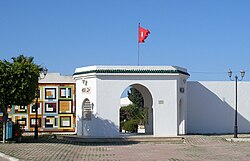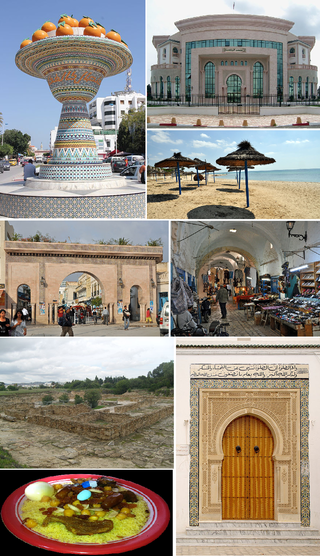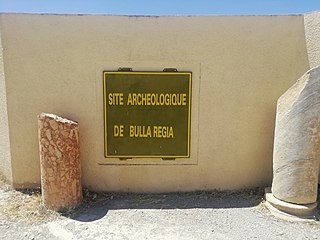 Exterior of museum in 2010 | |
 | |
| Location | Lamta, Tunisia |
|---|---|
| Type | Archaeological museum |
The Lamta Archaeological Museum is an archaeological museum located in Lamta, Tunisia. [1]
 Exterior of museum in 2010 | |
 | |
| Location | Lamta, Tunisia |
|---|---|
| Type | Archaeological museum |
The Lamta Archaeological Museum is an archaeological museum located in Lamta, Tunisia. [1]
The purpose of the museum, [1] [2] inaugurated in 1992, is to host the abundant antiquity collections found in the region and explain the history of the area, starting from the arrival of Phoenician sailors in the settlement to the Roman period and early Christian era.
The museum is located on the seashore, on the north-eastern corner of the antique town of Leptiminus (also named Leptis Parva), which repeatedly played a key role, both during the Punic era (for example during the Mercenary War, or in the Third Punic War, as the location where Hannibal returned to Africa), and in the Roman period (when it sided with Julius Caesar during his stand-off against Pompey entrentched in Hadrumetum - Sousse).
The garden around the museum shows in-situ portions of a Roman thermal complex (whose remains extend beyond the museum boundaries), with floors covered with mosaics and the hot room (caldarium) central heating system below the floor (hypocaust) clearly visible and various sculptures.
The museu's modern building is built like some antique villas, with a rectangular building with a vaulted entranceway leading to three rooms opening onto an interior courtyard hosting a garden surrounded by a columned portico.
One room is dedicated to the Punic period, with poteries and a representative collection of the various finds in the necropolis surroundering the museum. In addition to a reconstitution of the most common urn burial set-up with a tube allowing the living to celebrate on the tomb memorial ceremonies and allowing them to pour libations into the tomb, the museum hosts a rare wooden sarcophagus from the Punic period (3rd century BCE). [3]
A second room is dedicated to the Roman and early Christian period. A statue of the emperor Trajan (who promoted the town to the coveted statute of Roman colony between 98 and 117 CE) [4] and some mosaics from the nearby archeological site of Uzita (a mosaic of the seasons, a mosaic of Venus "anadyomene", i.e. rising from the sea, surrounded by cupids) stand out among the various sculptures and honorary plaques of funerary inscriptions. The piece which particularly stands out is an exceptional sculpted Christian marble sarcophagus, where the deceased, portrayed in his rich landowning context - with a hunting party, his horse, his dog, servants and friends as well as his wife waiting for him at home - comes to the time of death, in front of Christ seated on the throne, surrounded by the apostles Peter and Paul, and transitions to the afterlife where his friends (with local names of non-Roman origin) have preceded him. [5] [6]
A third room was opened in 1994, in cooperation with Michigan University. Various types of amphorae discovered on site are displayed, and the exhibit explains how their study can provide data on trade flux in antiquity. Hydraulic systems and building techniques of the Roman period are also presented. The most precious pieces of the collection are several colorful Christian mosaics found in a nearby underground church (a basilica in a catacomb complex). [7] [8]




Sousse or Soussa is a city in Tunisia, capital of the Sousse Governorate. Located 140 km (87 mi) south of the capital Tunis, the city has 271,428 inhabitants (2014). Sousse is in the central-east of the country, on the Gulf of Hammamet, which is a part of the Mediterranean Sea. Its economy is based on transport equipment, processed food, olive oil, textiles, and tourism. It is home to the Université de Sousse.

Hadrumetum, also known by many variant spellings and names, was a Phoenician colony that pre-dated Carthage. It subsequently became one of the most important cities in Roman Africa before Vandal and Umayyad conquerors left it ruined. In the early modern period, it was the village of Hammeim, now part of Sousse, Tunisia.

Lemta, historically Leptiminus, is a town in Tunisia with a history going back over 3,000 years.

Nabeul is a coastal town located in northeastern Tunisia, on the south coast of the Cape Bon peninsula and surrounded by the Mediterranean Sea on both sides. It is the first seaside resort in Tunisia. It is known for its agricultural riches and its touristic potentials. The city had a population of 73,128 as of the 2014 census.

Maktar or Makthar, also known by other names during antiquity, is a town and archaeological site in Siliana Governorate, Tunisia.

The Church of Saint Demetrius, or Hagios Demetrios, is the main sanctuary dedicated to Saint Demetrius, the patron saint of Thessaloniki, dating from a time when it was the second largest city of the Byzantine Empire. Since 1988, it has been on the UNESCO World Heritage List as a part of the site Paleochristian and Byzantine monuments of Thessaloniki.

Santa Costanza is a 4th-century church in Rome, Italy, on the Via Nomentana, which runs north-east out of the city. It is a round building with well preserved original layout and mosaics. It has been built adjacent to a horseshoe-shaped church, now in ruins, which has been identified as the initial 4th-century cemeterial basilica of Saint Agnes. Santa Costanza and the old Saint Agnes were both constructed over the earlier catacombs in which Saint Agnes is believed to be buried.

Bulla Regia was a Berber, Punic, and Roman town near present-day Jendouba, Tunisia. Its surviving ruins and archaeological site are noted for their Hadrianic-era semi-subterranean housing, a protection from the fierce heat and effects of the sun. Many of the mosaic floors have been left in place; others may be seen at the Bardo Museum in Tunis. There is also a small museum connected with the site.

The National Archaeological Museum is a museum in Madrid, Spain. It is located on Calle de Serrano beside the Plaza de Colón, sharing its building with the National Library of Spain.

Althiburos was an ancient Berber, Carthaginian, and Roman settlement in what is now the Dahmani Delegation of the Kef Governorate of Tunisia. During the reign of emperor Hadrian, it became a municipality with Italian rights. It was the seat of a Christian bishop from the 4th to 7th centuries. The settlement was destroyed during the Muslim invasions and the area's population center moved to Ebba Ksour on the plain. This left Althiburos's ruins largely intact; they were rediscovered by travelers in the 18th century.

The Bardo National Museum is a museum of Tunis, Tunisia, located in the suburbs of Le Bardo.
The Sfax Archaeological Museum is an archaeological museum located in Sfax, Tunisia.

The Sousse Archaeological Museum is an archaeological museum located in Sousse, Sousse Governorate, Tunisia.

Carthage National Museum is a national museum in Byrsa, Tunisia. Along with the Bardo National Museum, it is one of the two main local archaeological museums in the region. The edifice sits atop Byrsa Hill, in the heart of the city of Carthage. Founded in 1875, it houses many archaeological items from the Punic era and other periods.

The Ksour Essef cuirass is an ancient triple-disc cuirass found in a Punic tomb in 1909 not far from Ksour Essef, Tunisia.
The Mahdia Museum is a museum in Tunisia specialising in Tunisian archaeology and heritage. It is located in the city of Mahdia.

Nabeul Museum is an archaeological museum located in Nabeul, Tunisia. It was established in 1984.

Sétifis, was a Roman town located in northeastern Algeria. It was the capital of the Roman province called Mauretania Sitifensis, and it is today Setif in the Sétif Province (Algeria).

Melite or Melita was an ancient city located on the site of present-day Mdina and Rabat, Malta. It started out as a Bronze Age settlement, which developed into a city called Maleth under the Phoenicians, and became the administrative centre of the island. The city fell to the Roman Republic in 218 BC, and it remained part of the Roman and later the Byzantine Empire until 870 AD, when it was captured and destroyed by the Aghlabids. The city was then rebuilt and renamed Medina, giving rise to the present name Mdina. It remained Malta's capital city until 1530.

The National Museum of Utica is a museum dedicated to archeology in Tunisia located in Utica. The museum is dedicated to preserving important historical objects from the history of North African civilizations.
{{cite journal}}: Cite journal requires |journal= (help)